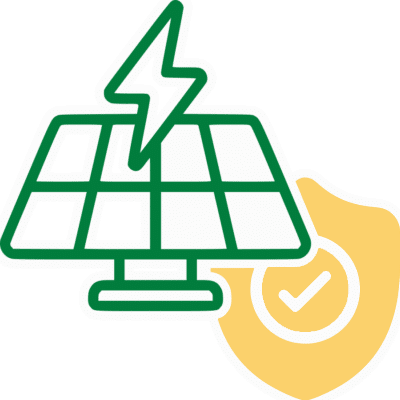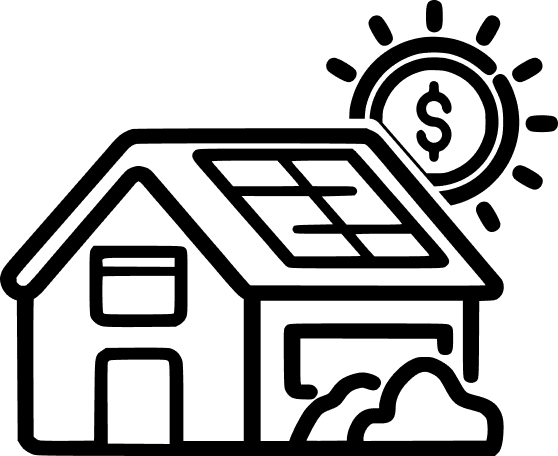
The patented technology used in our solar panels ensures maximised efficiency – even in low light – which means greater savings for our clients year round.

Research shows consumers are 100 times more likely to return a standard panel over a SunPower Panel, a testament to their quality.

The most comprehensive warranties available on the Australian market, with a full 40 Year Warranty and no hidden fine print.
Solar Panels
Experience the Power of Top-Tier Monocrystalline Solar Panels in Adelaide
Step into the world of renewable energy with Adelaide’s leading provider of monocrystalline solar panels.
At Energy Buster, we bring you cutting-edge, high-efficiency technology that perfectly aligns with Adelaide’s sunny climate. Our monocrystalline solar panels are designed for performance and longevity by not only harnessing the sun’s power efficiently but also offering unrivalled durability, ensuring your investment pays off for years to come.
More than a way to stay on top of household bills, the sleek, aesthetic design of our home solar panels also add a touch of modern elegance to your home or business.
Are you ready to embrace a sustainable future and lower energy bills? Place your trust in our quality, expertise, and commitment to a brighter, cleaner future and experience the difference for yourself.

What is Monocrystalline?
Monocrystalline refers to the type of silicon used in the photovoltaic cells. Monocrystalline silicon is composed of a single, continuous crystal structure. This crystal structure allows for free and unobstructed flow of electrons, thereby enhancing the efficiency.
Monocrystalline silicon solar panels are usually identified by their black colour and the rounded edges of the cells. They are known to offer the highest efficiency among different types of panels, perform well in cool and high sunlight conditions, and take up less space due to their efficiency.
At Energy Buster, we’re a proud SunPower monocrystalline solar panel supplier. Compared to conventional monocrystalline cells, they are more efficient as they are able to capture more sunlight. This is due to the grid-line electrical contacts on the rear of the cell. Having no grid lines means they can absorb the maximum amount of sun.
In addition, they are not affected by shading. This results in consistent power output compared to standard monocrystalline cells which can lose output or in some cases stop working altogether if a panel is partially covered.
What is the difference between monocrystalline and polycrystalline panels?
Monocrystalline and polycrystalline solar panels are both types of panels made from silicon, but there are a few key differences between them:
- Structure of Silicon: They are made from single-crystal silicon, while polycrystalline panels are made from multi-crystal silicon. This structural difference leads to a few functional and aesthetic differences.
- Efficiency: They are generally more efficient than polycrystalline panels. The single-crystal structure allows for a freer flow of electrons, reducing the amount of energy lost as heat and thereby increasing efficiency. This means you might need fewer panels to generate the same amount of power, making them a good option for limited spaces.
- Cost: Polycrystalline panels are usually less expensive to manufacture and hence to buy, because the process of creating multi-crystal silicon is simpler and results in less waste.
- Appearance: They typically have a dark black color due to the way light interacts with the single crystal structure. On the other hand, polycrystalline panels tend to have a blue hue, a result of the scattered light from the multiple crystal structures.
- Performance in Heat: They usually perform better in high-temperature conditions compared to polycrystalline panels. They have a lower temperature coefficient, meaning their performance decreases less as temperature rises.
Overall, these panels have higher efficiency (i.e. higher power output per unit), which is beneficial if roof space is limited. They also tend to perform better in lower light conditions and have longer lifespan.
Both types have their advantages and are more suitable for different situations. The best choice for you will depend on your specific needs, budget, and the available space for installation.
Upgrade to sustainable energy with our comprehensive solar panel packages, tailored for efficiency and cost savings.
Who are monocrystalline solar panels ideal for?
Here are a few examples:
- Homeowners with Limited Space: Given their higher efficiency, they generate more power compared to other types. Therefore, they’re a great choice for homeowners with limited roof space.
- Individuals Living in High-Temperature Areas: Monocrystalline solar panels generally have better heat resistance and a lower temperature coefficient than other types, meaning they perform better in hot climates with minimal performance decrease.
- People Seeking Long-Term Investment: Monocrystalline silicon solar panels have a longer lifespan compared to other panel types. So, if you’re planning to live in your house for a long time, the higher upfront cost of these panels can be offset by their durable and efficient performance over time.
It’s always a good idea to consult with a professional to find the best solution for your situation.
Who is the best monocrystalline solar panel manufacturer?
SunPower is considered the best monocrystalline solar panel manufacturer. Known for their premium quality and high-efficiency panels, the company has been a leading name in the industry for decades.
Below you may find the reasons why SunPower is considered the best choice.
- Their patented Maxeon technology. These cells are designed with a solid copper backing which allows for exceptional strength and resistance to cracking or corrosion. This innovation contributes to their industry-leading efficiency rates, sometimes exceeding 22%.
- Excellent durability. They’re rigorously tested to ensure they can withstand harsh weather conditions, from strong winds to high temperatures. Their panels come with a robust 40-year warranty, which covers not just the panels themselves, but also their performance, ensuring they will operate at a high level for many years.
- Comprehensive solutions, including inverters and energy storage options. Their panels are not only high-performing but also aesthetically pleasing, offering a sleek, low-profile design.
While SunPower’s solar panels tend to be more expensive than some other options, many customers find the higher upfront cost to be worth it over the long term due to the panels’ superior efficiency and durability.
Maxeon and SunPower Performance Series are more advanced versions of conventional monocrystalline panels.
What factors affect monocrystalline solar panels cost?
The cost can vary greatly depending on the size of the system, the brand, and the installation costs.
The exact cost will depend on several factors, including:
- Specific brand
- Complexity of installation
- Any incentives or rebates available
Keep in mind, renewable power is an investment that can pay for itself over time through reduced electricity bills and potential feed-in tariffs.
Monocrystalline solar panel benefits
✔ High Efficiency: Monocrystalline solar panels in Adelaide are the most efficient type because they’re made from a single crystal structure. This allows for easy electron flow, resulting in less resistance and higher efficiency.
✔ Longevity: These panels are known for their durability and long lifespan. Many manufacturers offer warranties for 25 years or more, but panels can last much longer if properly maintained.
✔ Space-Efficient: Due to their high efficiency, fewer monocrystalline solar panels are needed to produce the same amount of energy compared to other types. This makes them an excellent choice for rooftops with limited space.
✔ Aesthetics: Many people prefer the sleek, black appearance of monocrystalline solar panels compared to the blue tint of polycrystalline panels.
✔ High Performance: Monocrystalline silicon solar panels tend to have better performance in low-light conditions compared to other types of panels.
✔ Eco-Friendly: By harnessing renewable energy, monocrystalline solar panels help reduce greenhouse gas emissions and dependence on fossil fuels.
Monocrystalline solar panel installation process
The installation process for monocrystalline solar panels in Adelaide typically involves several key steps:
Step One: Consultation and Site Assessment
This initial step involves evaluating your property’s suitability for the installation, determining the right system size based on your energy needs, and discussing the best placement for the panels.
Step Two: Design and Planning
Based on the assessment, the provider designs a system tailored to your home or business. This includes choosing the right type and number of panels, inverters, and other necessary equipment.
Step Three: Approvals and Permits
Before installation can begin, necessary permits must be obtained, and the planned installation must meet local and national regulations.
Step Four: Installation
Professional installers mount the panels on your roof or chosen location, install inverters and connect the system to your business or home’s electrical grid. This process typically takes one to three days.
Step Five: Testing and Commissioning
After installation, the system is thoroughly tested to ensure everything is working correctly. The system is then connected to the grid, and the local utility company is notified to commence the new service.
Step Six: Monitoring and Maintenance
Once operational, the performance of your system can be monitored, often through an online app. Regular maintenance checks ensure the system continues to operate efficiently.
If you think that purchasing panels is the right thing for you, then the next step is to decide on the best brand and system size. Get in touch with us by either calling us on (08) 7120 6377 or by filling out our fast free quote form.






















































